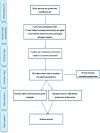Mothers' knowledge and experience concerning presurgical orthopedic management for infants with cleft lip and palate
- PMID: 34568204
- PMCID: PMC8423153
- DOI: 10.4103/jos.JOS_47_20
Mothers' knowledge and experience concerning presurgical orthopedic management for infants with cleft lip and palate
Abstract
Objectives: The present study aimed to assess the level of mothers' knowledge toward cleft lip and palate and their experience concerning presurgical orthopedic management.
Materials and methods: This was a cross-sectional study where the mothers were invited to complete a self-administered validated and reliable questionnaire. The questionnaire included questions that aimed to assess mother's knowledge related to the most prevalent aspects of cleft lip and palate anomaly itself and additionally, questions associated with presurgical orthopedic treatment as an adjunct therapy. Descriptive statistics were used to define the characteristics of the study variables. Chi-square test was utilized to assess relationships between categorical variables.
Results: Totally, 145 mothers completed the survey (response rate was 73%). Forty-six (46%) of the mothers provided an incomplete or improper definition of the anomaly and 35 (24%) claimed that they know the cause of the anomaly. The majority of mothers did not identify family history as a risk factor; consanguinity was identified in 29% (n = 42). Of the total, 58 mothers (40%) agreed that dental management of CLP requires teamwork and the majority (n = 126, 87%) recognized the plastic surgeon as the most important specialist. Mothers aged 20-30 years old (n = 42, 53%), and those who are university graduates (n = 38, 48%), as well as employed mothers (n = 52, 66%) have in general a higher degree of knowledge regarding cleft lip and palate (P < 0.001). More than half of the mothers (n = 70, 57%) reported that presurgical orthopedic treatment was useful and needed for their infants.
Conclusions: Most of the mothers reported a high level of knowledge about cleft lip and palate and they experienced the usefulness of the orthopedic appliances for their infants. However, there was uncertainty in some parts such as definition, diagnosis, causes, and risk factors for cleft lip and palate. Therefore, understanding the causes of cleft lip and palate, as well as comprehensive education concerning the essential role of the orthopedic appliances to improve cleft lip and palate are crucial for mothers to improve their infants' quality of life.
Keywords: Cleft lip and palate; mother's experience; mother's knowledge; orthopedics management.
Copyright: © 2021 Journal of Orthodontic Science.
Conflict of interest statement
There are no conflicts of interest.
Similar articles
-
The Perception and Experience of Parents of Children with Cleft Lip and Palate Concerning the Use Pre-Surgical Infant Orthopedics: A Questionnaire-Based Cross-Sectional Survey.Children (Basel). 2022 Jul 15;9(7):1054. doi: 10.3390/children9071054. Children (Basel). 2022. PMID: 35884038 Free PMC article.
-
Caregivers' Experience with Lip Taping as a Presurgical Orthopedic Treatment for Cleft Lip and Palate Defects.Children (Basel). 2024 Mar 10;11(3):332. doi: 10.3390/children11030332. Children (Basel). 2024. PMID: 38539367 Free PMC article.
-
Awareness of feeding, growth and development among mothers of infants with cleft lip and/or palate.Heliyon. 2019 Dec 9;5(12):e02900. doi: 10.1016/j.heliyon.2019.e02900. eCollection 2019 Dec. Heliyon. 2019. PMID: 31890935 Free PMC article.
-
Long-term effects of presurgical infant orthopedics in patients with cleft lip and palate: a systematic review.Cleft Palate Craniofac J. 2011 Sep;48(5):587-95. doi: 10.1597/10-008. Epub 2010 Sep 17. Cleft Palate Craniofac J. 2011. PMID: 20858135 Review.
-
Presurgical orthopedics in the surgical management of unilateral cleft lip and palate.Plast Reconstr Surg. 1995 Apr;95(4):755-64. doi: 10.1097/00006534-199504000-00024. Plast Reconstr Surg. 1995. PMID: 7892327 Review.
Cited by
-
Enhancing Presurgical Infant Orthopedic Appliances: Characterization, Mechanics, and Biofilm Inhibition of a Novel Chlorhexidine-Halloysite Nanotube-Modified PMMA.Int J Biomater. 2024 May 10;2024:6281972. doi: 10.1155/2024/6281972. eCollection 2024. Int J Biomater. 2024. PMID: 38962288 Free PMC article.
-
The Perception and Experience of Parents of Children with Cleft Lip and Palate Concerning the Use Pre-Surgical Infant Orthopedics: A Questionnaire-Based Cross-Sectional Survey.Children (Basel). 2022 Jul 15;9(7):1054. doi: 10.3390/children9071054. Children (Basel). 2022. PMID: 35884038 Free PMC article.
-
The accuracy and retention of presurgical infant orthopaedics constructed from different polymer materials: A comparative study.J Taibah Univ Med Sci. 2024 Feb 5;19(2):379-389. doi: 10.1016/j.jtumed.2024.01.005. eCollection 2024 Apr. J Taibah Univ Med Sci. 2024. PMID: 38370166 Free PMC article.
-
Caregivers' Experience with Lip Taping as a Presurgical Orthopedic Treatment for Cleft Lip and Palate Defects.Children (Basel). 2024 Mar 10;11(3):332. doi: 10.3390/children11030332. Children (Basel). 2024. PMID: 38539367 Free PMC article.
References
-
- Mossey P, Little J, Munger R, Dixon M, Shaw W. Cleft lip and palate. Lancet. 2009;374:1773–85. - PubMed
-
- Magdalenić-Meštrović M, Bagatin M. An epidemiological study of orofacial clefts in Croatia 1988-1998. J Cranio-Maxillofacial Surg. 2005;33:85–90. - PubMed
-
- Gorlin R, Cohen M, Hannekam R. 4th ed. New York: Oxford University Press; 2001. Syndromes of the Head and Neck.
-
- Zhang B, Jiao X, Mao L, Xue J. Maternal cigarette smoking and the associated risk of having a child with orofacial clefts in China: A case-control study. J Cranio-Maxillofacial Surg. 2011;39:313–8. - PubMed
LinkOut - more resources
Full Text Sources
Miscellaneous

